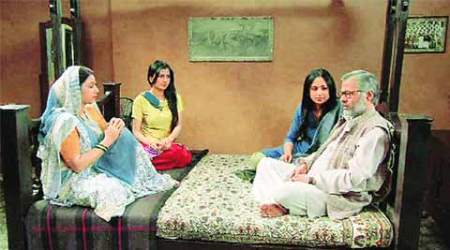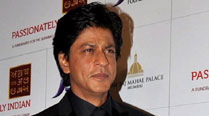 Khan said he wanted to direct Mughal E Azam after reading the same play, Anarkali by Syed Imtiaz Ali Taj, which had also inspired K Asif to make his iconic movie in 1960
Khan said he wanted to direct Mughal E Azam after reading the same play, Anarkali by Syed Imtiaz Ali Taj, which had also inspired K Asif to make his iconic movie in 1960
The entrance of the Jawaharlal Nehru Stadium looked nothing less than a gateway to a Mughal palace, decorated for the premiere of Feroz Abbas Khan’s Mughal-E-Azam broadway musical show. The stage was illuminated with more than 200 lights, over 350 crew members worked silently and efficiently in the backdrop, while actors successfully wowed the audience, recreating one of Indian cinema’s epic stories. Renowned Bollywood designer Manish Malhotra designed over 550 costumes for the musical, and for two hours, members of the audience were transported to a different era.
Khan, though, known for directing plays such as Saalgirah, Tumhari Amrita, Salesman Ramlal and Kuch Bhi Ho Sakta Hai, admited he had his reservations while recreating K Asif-directorial Mughal-E-Azamstarring Dilip Kumar and Madhubala. “I had inibitions that people might compare the movie with the play and, to be honest, I was scared. People often asked me why I am being a fool in remaking the film,” confessed Khan, in a conversation with indianexpress.com, after the premiere of the play in Delhi.
Khan said he wanted to direct Mughal-E-Azam after reading the same play, Anarkali by Syed Imtiaz Ali Taj, which had also inspired K Asif to make his iconic movie in 1960. “I was sure about Mughal-E-Azam as the movie has been adapted from a play called Anarkali and I wanted it again to be a play that no one can forget. We have reclaimed the play back.”
On September 8, the premiere was attended by the crème de la crème of Indian politics – from Union Finance Minister Arun Jaitley, Information and Broadcasting and Textiles Minister Smriti Irani to Nitin Gadkari and Jyotiraditya Scindia.
The play opened with a note from Lata Mangeshkar and grabbed the attention of the audience with its live singing that included the iconic songs from the film such as ‘Pyar kiya toh darna kya’ and also a series of dazzling Kathak performances by 38 classically trained dancers, beautifully choreographed by Mayuri Upadhya,which left the audience mesmerised. Upadhya’s work has been showcased in national and international dance festivals like The Other Festival, Attakalari Bangalore Biennial International Festival of Movement Arts, etc. “We have retained the form without deconstructing it and have not used Bollywood with it,” said Upadhya. The casting is also spot-on and could not have been better.

The lead actors, who have many years of experience in theatre, spent hours rehearsing for the role. They not only had the challenge of the play’s two hour length, but the female lead Anarkali had to take on the tricky task of singing live flawlessly even while dancing, which Priyanka Barwe did beautifully. The diction of the actors, to the sincerity of their performance, everything would make the audience fall in love with the play.
“The story of Anarkali, her pain, forced me to direct the play. I still do not understand what was her fault. It is a tribute to K Asif sahab,” said Khan, explaining the movie references in this magnum opus. Explaining why he wanted to bring the play to Delhi, Khan said, “If I would not have brought the play for the Delhi audience, it would have been incomplete. The city is associated with the Mughals and the history.”
“I have made the play in a way that this generation can related to it. I have made all my female characters strong. I wanted to keep the play as original as I could, but also wanted to play with the voice of the character,” added Khan.
Manish Malhotra, whose resplendent lehengas and sherwanis wonderfully recreated the opulence of the Mughal era and were integral to the elevating the musical from just another play to this grandiose spectacle, said designing the costumes for this project was anything but usual. “Each costume had to speak for the character. I used pure fabric and flairs for the dancers. The costume of Anarkali is not similar to that of Madhubala ji in the movie. Designing for a play is different from designing for Bollywood. The actors do not get enough time to change after every scene. I had to use velcro and made sure that costumes are light-weight to help quick change,” Malhotra explained. These tricks were visible in the layers that comprised the costumes of the various characters, such as that of Anarkali, whose voluminous angarakha jacket is easily and effortlessly taken off on-stage to reveal a gorgeous red wedding wear, or the swift change of Akbar and Salim into battle raiment and back to their court finery, all keeping in line with the story.
A special mention should be made of the set design and engineering that is not frequently seen on the Indian stage. From changing scenes to using the layered screens to reflect a dramatic change in scenery and location, the transitions are smooth and mostly seemless. Those intrigued about how the Hall of Mirrors can be recreated on a proscenium will be in for a treat.
Khan’s grand Mughal-E-Azam may seem a tad bit stretched at times, but there is no doubt that it is an audio-visual extravaganza that will be a joy to behold.
Mughal-E-Azam will be performed till September 17 at the Jawaharlal Nehru Auditorium. If you have not watched it yet, then tickets are available at bookmyshow.com for Rs 500 to 10,000.

